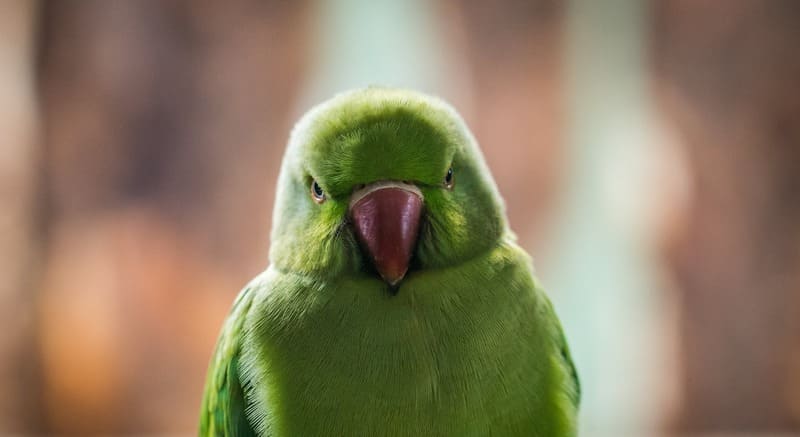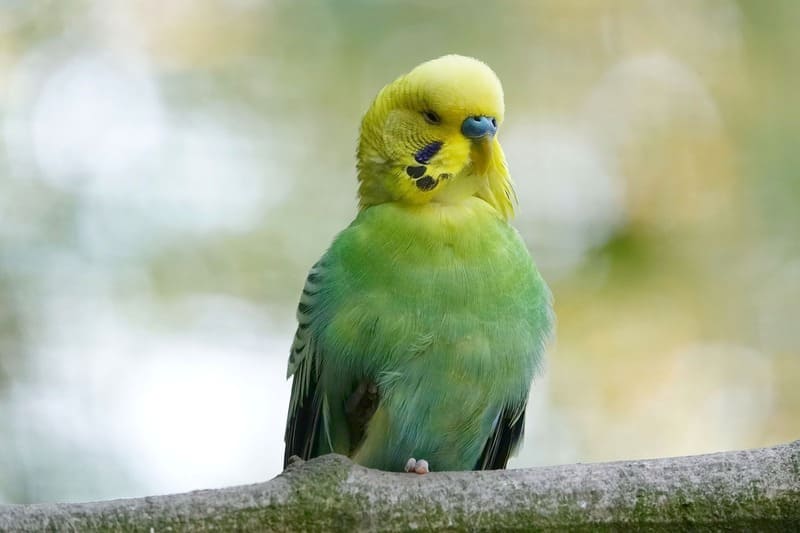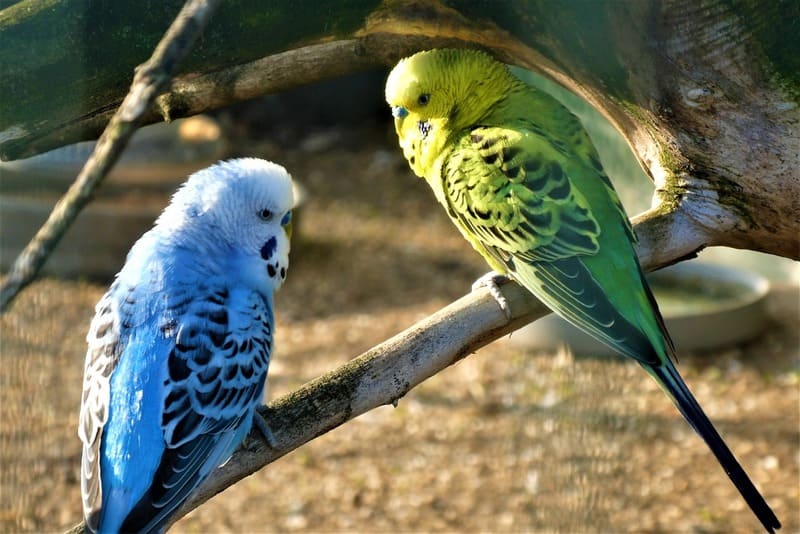Parakeets, also known as budgies, are popular and beloved pet birds known for their vibrant plumage, lively personalities, and endearing behaviors. One of the charming behaviors often observed in parakeets is standing on one foot. This seemingly simple act raises questions and curiosity among bird enthusiasts and pet owners. Why do parakeets stand on one foot? Is there a specific reason behind this behavior, or is it merely a quirky habit? In this extensive exploration, we will delve into the fascinating world of parakeet behavior, decipher the potential reasons for their one-footed stance, and gain insights into their physiology, psychology, and overall well-being.

The Parakeet: A Brief Introduction
Before delving into the intriguing behavior of standing on one foot, let’s start with an introduction to the parakeet (Melopsittacus undulatus). Parakeets are small, intelligent, and highly social parrot species native to Australia. They are known for their playful and energetic nature, making them delightful companions for bird enthusiasts.
Key characteristics of parakeets include:
- Vibrant Plumage: Parakeets exhibit a stunning array of colors, including various shades of green, blue, yellow, and white. Their plumage is visually striking and adds to their appeal as pets.
- Social Behavior: Parakeets are incredibly social birds. They thrive on interaction with their human caregivers and enjoy the company of other parakeets. Their sociable nature makes them bond closely with their owners.
- Intelligence: Despite their small size, parakeets are intelligent birds. They have the ability to learn tricks, mimic sounds, and even develop a limited vocabulary.
- Acrobatic Skills: Parakeets are known for their acrobatic abilities. They enjoy flying, climbing, and exploring their environment. Their agility adds to their playful nature.
- Longevity: When well cared for, parakeets can have a relatively long lifespan, often exceeding 10 years, with some living up to 15 years or more.
The One-Footed Stance: Observations and Interpretations
One of the endearing behaviors exhibited by parakeets is standing on one foot. This behavior may be observed when a parakeet perches, relaxes, or sleeps. While it may appear simple, there are several potential reasons and interpretations for this one-footed stance. Let’s explore some of the key possibilities:
1. Temperature Regulation
One of the primary reasons parakeets stand on one foot is temperature regulation. Parakeets are highly sensitive to temperature changes and are susceptible to both heat stress and cold temperatures. By lifting one foot and tucking it close to their body, they can regulate their body temperature more effectively.
- Cooling Down: On hot days, parakeets may lift one leg to allow air circulation around the foot and reduce heat retention.
- Conserving Heat: In cooler environments or during the night, parakeets lift one leg to minimize heat loss through their feet. The blood vessels in their feet constrict to conserve warmth.
- Maintaining Comfort: This behavior helps parakeets maintain a comfortable body temperature, whether in a warm or cool setting.
2. Sleep Position
Parakeets often stand on one foot while sleeping. This is a common position adopted by many birds, not just parakeets. The one-footed sleep posture serves several purposes:
- Balance: It allows the bird to balance comfortably on a perch while sleeping, preventing falls or loss of balance during rest.
- Relaxation: The one-footed stance may be a more relaxed and comfortable way for parakeets to sleep.
- Conservation of Energy: Standing on one foot can help birds conserve energy while resting. This energy-saving position is especially important for wild parakeets in their natural habitat.
3. Behavioral Health
Standing on one foot can also be an indicator of the bird’s overall health and well-being. A parakeet that consistently stands on one foot while awake and active is likely healthy and comfortable in its environment. However, any sudden or prolonged change in this behavior may signal health concerns and should be investigated.
- Pain or Discomfort: Parakeets may lift one foot if they are experiencing discomfort or pain in one of their feet. In such cases, this behavior may be a response to an injury or an underlying health issue.
- Stress or Fear: Extreme stress or fear can also cause parakeets to stand on one foot. Sudden changes in their environment, the presence of predators, or loud noises may trigger this behavior.
4. Energy Conservation
The one-footed stance can be a way for parakeets to conserve energy during periods of inactivity. When parakeets are not engaged in play, feeding, or other active behaviors, they may lift one foot to rest and save energy. This is a common practice among birds, as it allows them to remain alert and ready for action when needed.
- Sleep and Rest: During periods of sleep and rest, parakeets typically stand on one foot to conserve energy. This energy-saving posture is a survival mechanism observed in many bird species.
- Vigilance: Even during rest, standing on one foot allows parakeets to maintain a degree of vigilance and be prepared to respond to potential threats.
5. Environmental Adaptation
In their natural habitat of Australia, wild parakeets often face varying environmental conditions. Standing on one foot may be an adaptation to the challenging Australian climate, which can include both extreme heat and cold. By adjusting their posture and behavior, parakeets can better cope with these conditions.
- Sun Exposure: On hot days, parakeets may lift one leg to reduce sun exposure on their feet and reduce the risk of overheating.
- Cold Tolerance: In colder weather, lifting one foot can help minimize heat loss through their extremities, aiding in temperature regulation.
- Adaptation: This behavior is a reflection of how parakeets have adapted to the diverse climate conditions in their native habitat.

The Role of Feet in Parakeet Behavior
The feet of parakeets are more than just functional appendages. They play essential roles in the bird’s daily life and are intricately linked to various aspects of their behavior and well-being:
1. Perching
Parakeets are excellent perching birds. Their feet are designed with a unique configuration that allows them to grasp and hold onto perches with ease. This foot structure is essential for their ability to roost, rest, and sleep comfortably on perches.
2. Climbing
Parakeets are active climbers, whether it’s climbing the bars of their cage, navigating branches in the wild, or exploring their environment. Their feet are well-suited for gripping and climbing, offering them stability and agility.
3. Handling Food
Parakeets use their feet and beaks to manipulate and handle food. They may hold food items with their feet while eating or use their feet to stabilize objects when chewing.
4. Temperature Regulation
As mentioned earlier, parakeets use their feet as a means of temperature regulation. The blood vessels in their feet can constrict or dilate to help control body temperature, making their feet a vital part of their thermoregulatory system.
5. Expression of Emotions
Parakeets can express emotions and moods through their feet. For example, a parakeet that is excited or happy may display animated foot movements and hopping, while a stressed or agitated parakeet may grip its perch tightly.
Health and Care Considerations
While the one-footed stance is generally a normal and healthy behavior for parakeets, there are situations where it can indicate health issues or discomfort. It’s essential for parakeet owners to be attuned to changes in their bird’s behavior, as these changes can be early signs of underlying health concerns. Here are some health and care considerations related to the one-footed stance:
1. Injury or Pain
Parakeets may stand on one foot if they have sustained an injury or are experiencing pain or discomfort in one of their feet. If you notice this behavior persisting or accompanied by signs of distress, it’s crucial to consult with an avian veterinarian for a thorough examination.
2. Behavioral Changes
Any significant and sudden change in your parakeet’s behavior, including alterations in their one-footed stance, should be taken seriously. Such changes can be indicative of stress, fear, or other emotional and psychological factors. Identifying and addressing the underlying causes of behavioral changes is essential for the bird’s well-being.
3. Nutritional Health
The health of a parakeet’s feet can be influenced by their nutritional well-being. Ensuring a balanced and nutritious diet that meets their specific dietary requirements is essential for maintaining healthy feet and overall health.
4. Environmental Conditions
Extreme environmental conditions, such as excessively hot or cold temperatures, can lead to changes in the way parakeets use their feet for temperature regulation. Providing a comfortable and suitable environment is crucial for their well-being.
5. Social Interaction
The one-footed stance can also be a sign of a parakeet’s comfort and contentment in their social environment. Social interactions, mental stimulation, and a bond with their human caregivers contribute to their overall happiness.

Providing a Suitable Environment for Parakeets
To promote the well-being of your parakeet and encourage natural behaviors, it’s important to provide a suitable environment that caters to their physical and psychological needs:
1. Spacious Cage
Parakeets need a spacious cage that allows them room to perch, fly, and exercise. Ensure that the cage is large enough to accommodate perches, toys, and room for your parakeet to move around comfortably.
2. Variety of Perches
Offer a variety of perches with different textures and diameters. This variety promotes foot health and provides exercise for their feet and leg muscles. Natural wood perches are often a favorite among parakeets.
3. Toys and Mental Stimulation
Parakeets are intelligent birds that require mental stimulation. Provide a variety of toys, including puzzles, swings, and interactive toys, to keep them mentally engaged.
4. Proper Nutrition
Offer a balanced diet that includes high-quality parakeet pellets, fresh vegetables, fruits, and occasional treats. Ensure access to clean and fresh water at all times.
5. Social Interaction
Parakeets thrive on social interaction. Spend time with your parakeet daily, engaging in conversation, play, and training. Their social nature is an essential aspect of their overall well-being.
6. Regular Health Check-Ups
Schedule regular check-ups with an avian veterinarian to monitor your parakeet’s health and address any potential concerns promptly.
7. Temperature Control
Maintain a suitable and consistent temperature in the environment where your parakeet lives. Ensure they are not exposed to extreme heat or cold, as this can affect their comfort and well-being.
Conclusion
The one-footed stance observed in parakeets is a multifaceted behavior that serves various functions. While it can be a natural response to temperature changes, a comfortable sleep posture, and an energy-conservation mechanism, it can also reflect their overall well-being and state of health. Understanding the context in which your parakeet displays this behavior is crucial for ensuring their happiness and health.
By providing a suitable environment, offering proper nutrition, and maintaining regular social interaction, you can create a nurturing and enriching environment for your parakeet. This, in turn, will contribute to their overall well-being and allow them to exhibit their endearing one-footed stance in a relaxed and contented manner.
